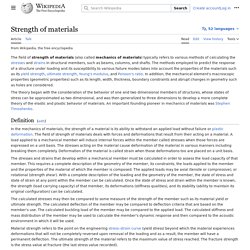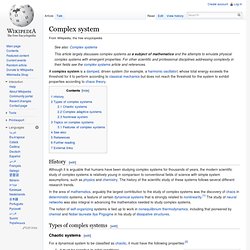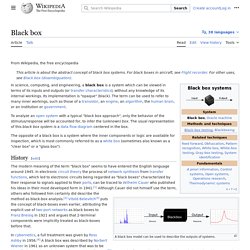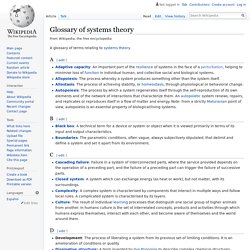

Strength of materials. The study of strength of materials often refers to various methods of calculating the stresses and strains in structural members, such as beams, columns, and shafts.

The methods employed to predict the response of a structure under loading and its susceptibility to various failure modes takes into account the properties of the materials such as its yield strength, ultimate strength, Young's modulus, and Poisson's ratio; in addition the mechanical element's macroscopic properties (geometric properties), such as its length, width, thickness, boundary constraints and abrupt changes in geometry such as holes are considered.
Definition[edit] Material strength refers to the point on the engineering stress–strain curve (yield stress) beyond which the material experiences deformations that will not be completely reversed upon removal of the loading and as a result the member will have a permanent deflection. The ultimate strength of the material refers to the maximum value of stress reached. Category:Alloys. Alloys are materials made up of more than one chemical element, at least one of which must be a metal.

The combination of elements has metallic properties that differ from those of the base, component elements. Subcategories This category has the following 27 subcategories, out of 27 total. Pages in category "Alloys" Category:Free online encyclopedias. Portal:Contents/Technology and applied sciences. Category:Handbooks and manuals. Category:Glossaries. Portal:Contents/Categories. Complex system. This article largely discusses complex systems as a subject of mathematics and the attempts to emulate physical complex systems with emergent properties.

For other scientific and professional disciplines addressing complexity in their fields see the complex systems article and references. A complex system is a damped, driven system (for example, a harmonic oscillator) whose total energy exceeds the threshold for it to perform according to classical mechanics but does not reach the threshold for the system to exhibit properties according to chaos theory. History[edit] Although it is arguable that humans have been studying complex systems for thousands of years, the modern scientific study of complex systems is relatively young in comparison to conventional fields of science with simple system assumptions, such as physics and chemistry. The history of the scientific study of these systems follows several different research trends.
Knowledge organization. The term knowledge organization (KO) (or "organization of knowledge", "organization of information" or "information organization") designates a field of study related to Library and Information Science (LIS).

In this meaning, KO is about activities such as document description, indexing and classification performed in libraries, databases, archives etc. These activities are done by librarians, archivists, subject specialists as well as by computer algorithms. KO as a field of study is concerned with the nature and quality of such knowledge organizing processes (KOP) as well as the knowledge organizing systems (KOS) used to organize documents, document representations and concepts. There exist different historical and theoretical approaches to and theories about organizing knowledge, which are related to different views of knowledge, cognition, language, and social organization.
Each of these approaches tends to answer the question: “What is knowledge organization?” Human body. The entire structure of a human being The study of the human body involves anatomy, physiology, histology and embryology.

The body varies anatomically in known ways. Physiology focuses on the systems and organs of the human body and their functions. Many systems and mechanisms interact in order to maintain homeostasis, with safe levels of substances such as sugar and oxygen in the blood. Black box. Device, system or object which can only be viewed in terms of its inputs and outputs with no knowledge of its internal workings In science, computing, and engineering, a black box is a device, system or object which can be viewed in terms of its inputs and outputs (or transfer characteristics), without any knowledge of its internal workings.

Its implementation is "opaque" (black). Complex system. Category:Physical systems. Physical system. The split between system and environment is the analyst's choice, generally made to simplify the analysis.

For example, the water in a lake, the water in half of a lake, or an individual molecule of water in the lake can each be considered a physical system. An isolated system is one that has negligible interaction with its environment. Often a system in this sense is chosen to correspond to the more usual meaning of system, such as a particular machine. See also[edit] External links[edit] Information system. Combination of information, resources, activities and people that support tasks in an organization; group of components that interact to produce information An information system (IS) is a formal, sociotechnical, organizational system designed to collect, process, store, and distribute information.[1] In a sociotechnical perspective, information systems are composed by four components: task, people, structure (or roles), and technology.[2] A computer information system is a system composed of people and computers that processes or interprets information.[3][4][5][6] The term is also sometimes used to simply refer to a computer system with software installed.

Any specific information system aims to support operations, management and decision-making.[8][9] An information system is the information and communication technology (ICT) that an organization uses, and also the way in which people interact with this technology in support of business processes.[10] Overview[edit] Related terms[edit] Glossary of systems theory. From Wikipedia, the free encyclopedia Jump to navigationJump to search A glossary of terms relating to systems theory.

A[edit] B[edit] C[edit] System. A schematic representation of a closed system and its boundary A system is a set of interacting or interdependent components forming an integrated whole.[1] Every system is delineated by its spatial and temporal boundaries, surrounded and influenced by its environment, described by its structure and purpose and expressed in its functioning.

Fields that study the general properties of systems include systems science, systems theory, systems modeling, systems engineering, cybernetics, dynamical systems, thermodynamics, complex systems, system analysis and design and systems architecture. They investigate the abstract properties of systems' matter and organization, looking for concepts and principles that are independent of domain, substance, type, or temporal scale. Category:Data management. From Wikipedia, the free encyclopedia Jump to navigationJump to search Subcategories This category has the following 41 subcategories, out of 41 total. Category:Data. Data. Some of the different types of data. Data and information are often used interchangeably; however, the extent to which a set of data is informative to someone depends on the extent to which it is unexpected by that person.
The amount of information content in a data stream may be characterized by its Shannon entropy. While the concept of data is commonly associated with scientific research, data is collected by a huge range of organizations and institutions, including businesses (e.g., sales data, revenue, profits, stock price), governments (e.g., crime rates, unemployment rates, literacy rates) and non-governmental organizations (e.g., censuses of the number of homeless people by non-profit organizations). Category:Categories by type. Portal:Contents/Categories.
Category:Numbers. List of numbers. Rational numbers[edit] Natural numbers[edit] Category:Number-related lists. List of symbols. This is a list of graphical signs, icons, and symbols. Languages[edit] Many (but not all) graphemes that are part of a writing system that encodes a full spoken language are included in the Unicode standard, which also includes graphical symbols. See: The remainder of this list focuses on graphemes not part of spoken language-encoding systems. Basic communication[edit] Category:Information. Category:Information science. Information. The ASCII codes for the word "Wikipedia" represented in binary, the numeral system most commonly used for encoding textual computer information In Thermodynamics, information is any kind of event that affects the state of a dynamic system that can interpret the information. Etymology[edit] The English word was apparently derived from the Latin stem (information-) of the nominative (informatio): this noun is derived from the verb informare (to inform) in the sense of "to give form to the mind", "to discipline", "instruct", "teach".
Inform itself comes (via French informer) from the Latin verb informare, which means to give form, or to form an idea of. Furthermore, Latin itself already contained the word informatio meaning concept or idea, but the extent to which this may have influenced the development of the word information in English is not clear. Category:Industries. Category:Human activities. Category:Aeronautics. Lists of countries and territories. This list is incomplete. You can help by expanding it. List of timelines. From Wikipedia, the free encyclopedia. Portal:Contents/Technology and applied sciences. Category:Technology-related lists. Lists of countries and territories.
Portal:Contents/Portals. From Wikipedia, the free encyclopedia Jump to navigationJump to search. Portal:Contents/Lists. Category:Wikipedia indexes. Portal:Contents/A–Z index. Index of electronics articles. Index of electronics articles From Wikipedia, the free encyclopedia Jump to navigation Jump to search This is an index of articles relating to electronics and electricity or natural electricity and things that run on electricity and things that use or conduct electricity. Category:Technology by type. Portal:Contents/Glossaries. From Wikipedia, the free encyclopedia Jump to navigationJump to search. Portal:Contents/Natural and physical sciences. Category:Manufactured goods. The Eight Most Abundant Elements in the Earth's Crust. VitacopS/iStock/GettyImages Elements are the simplest form of matter. They are substances made from one type of atom that cannot be broken down or separated into a simpler form.
All other matter is made from compounds or combinations of these fundamental substances. Abundance of elements in Earth's crust. From Wikipedia, the free encyclopedia. Category:Properties of chemical elements. If everyone reading this gave $3, we could keep Wikipedia thriving for years to come. Maybe later. Portal:Chemical elements.
Abundances of the elements (data page) Abundance of the chemical elements. Resin identification code. Category:Lists of standards. Category:Standards. List of international common standards. Index of standards articles. Numbering scheme. List of Dewey Decimal classes. Category:Identifiers. Recycling codes. Library of Congress Classification. Unique identifier. Category:Industry. Category:Information systems. Index of semiotics articles. Category:Aviation. List of dinosaur genera. Secondary sector of the economy. The Penguin Dictionary of Curious and Interesting Numbers. Portal:Contents/Technology and applied sciences.